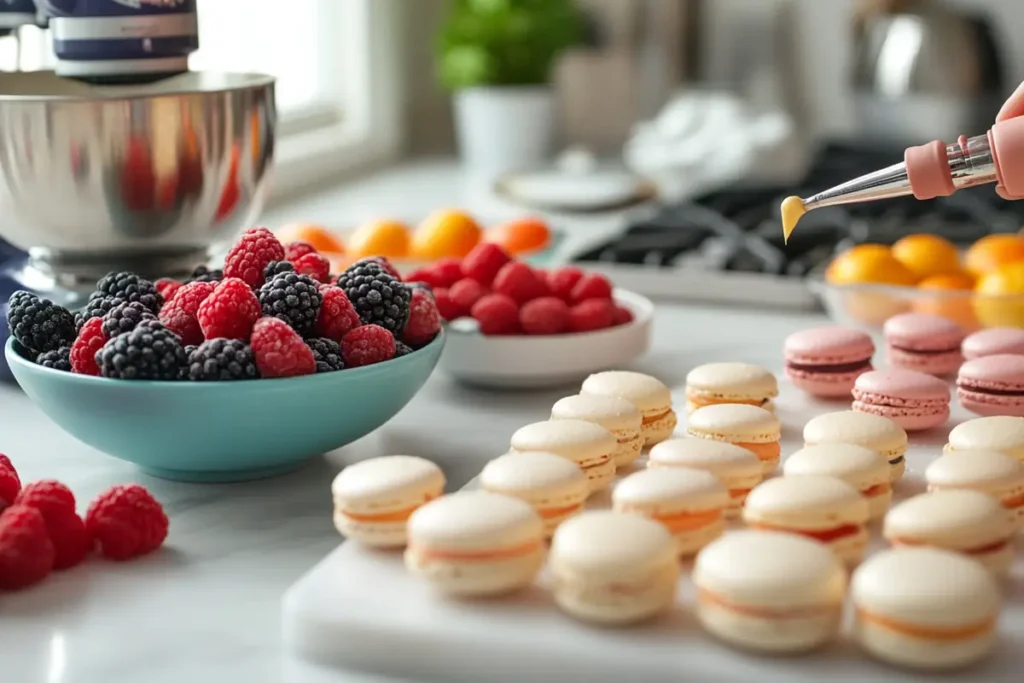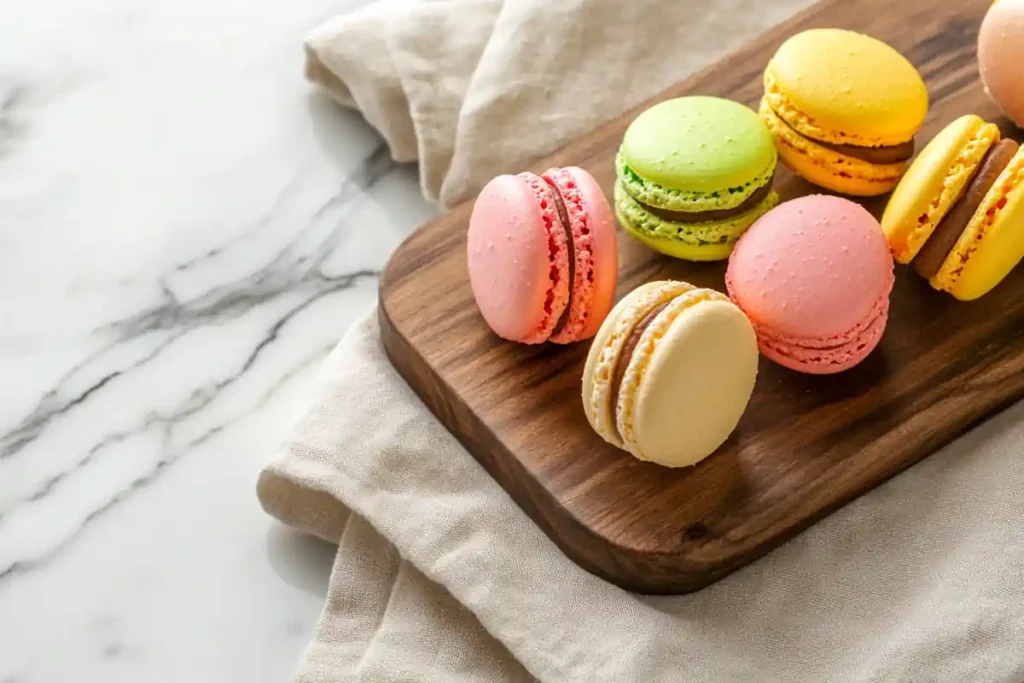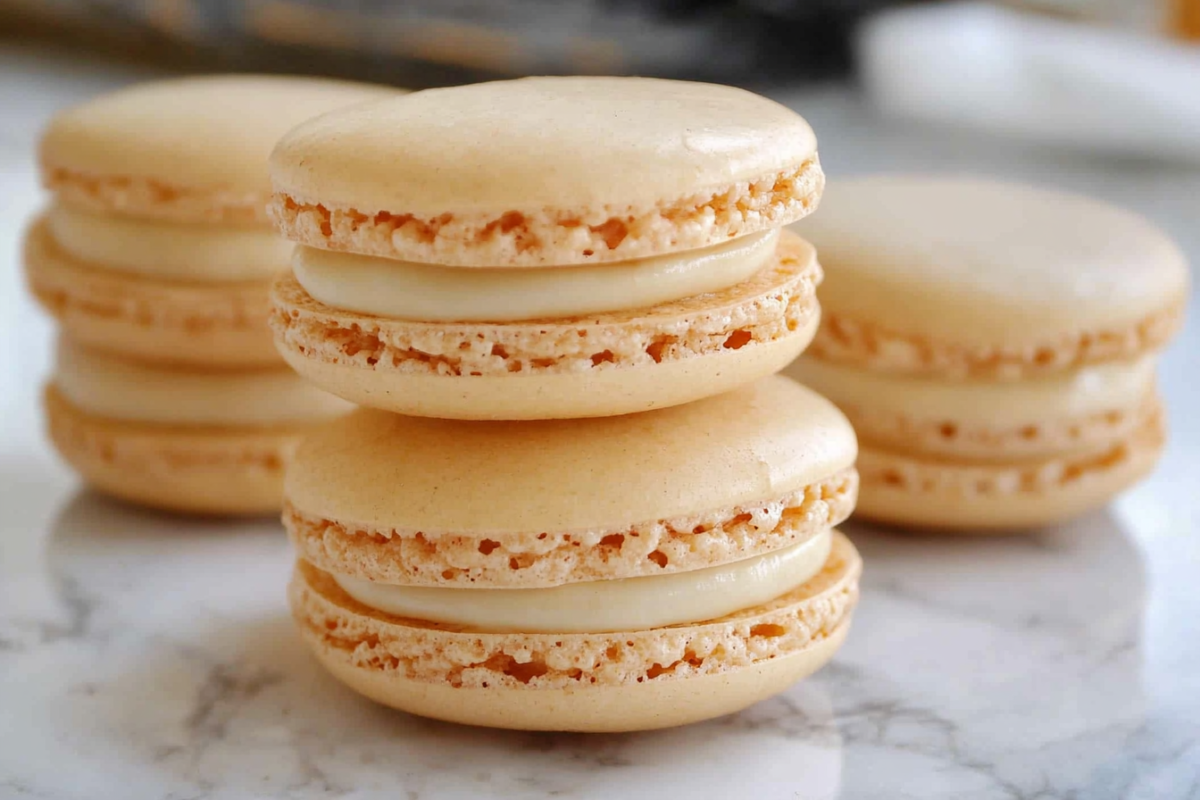introduction:
Macarons are a delightful French pastry that captures the hearts of dessert lovers worldwide. But what truly sets them apart is their endless flavor possibilities. From fruity and nutty to herbal and chocolatey, macarons can be customized in countless ways. In this article, we’ll explore the best way to flavor macarons, covering everything from shell preparation to filling innovations. Let’s dive into the delicious world of macarons!
Understanding Macarons and Their Popularity
A Brief History of Macarons
The macaron, a sweet meringue-based confection, originated in Italy but gained widespread fame in France. Initially introduced by Italian chefs in the 16th century, it quickly became popular among French royalty due to its elegant appearance and delightful taste. Over time, bakers refined the recipe, transforming the simple almond-based treat into a luxurious dessert with smooth shells and creamy fillings. Eventually, the modern double-layered macaron emerged, featuring two delicate shells paired with a flavorful filling in between. Consequently, the macaron evolved into a symbol of sophistication and culinary artistry, admired worldwide for its elegance and versatility.
The Appeal of Flavored Macarons
What makes macarons truly irresistible is their endless flavor possibilities, allowing bakers to craft unique and memorable desserts. In fact, their appeal lies not only in their exquisite taste but also in their striking visual presentation. By experimenting with different fillings, shells, and even toppings, bakers can create distinctive flavor profiles that cater to a variety of preferences. For example, pairing a tangy lemon filling with a sweet vanilla shell results in a refreshing citrus burst. Additionally, modern bakers often incorporate trendy ingredients like matcha, lavender, and salted caramel, enhancing the macaron’s allure. Consequently, these creative combinations have solidified macarons’ status as a must-have dessert for elegant celebrations, intimate gatherings, and even everyday indulgences.
This adaptability, coupled with their melt-in-your-mouth texture, ensures that macarons remain timelessly popular among dessert enthusiasts around the globe.
Basics of Macaron Composition
Components of a Traditional Macaron
A macaron consists of two main components: the shell and the filling. Each plays a crucial role in creating a perfectly balanced dessert. The delicate shell provides a crispy exterior, while the filling delivers rich, creamy flavors that melt in your mouth. Combining the right ingredients ensures an exceptional macaron experience.
The Shell
The macaron shell is a meringue-based pastry made from almond flour, egg whites, and powdered sugar. It has a glossy, smooth surface with the characteristic “feet” at its base. The shell’s crisp exterior contrasts beautifully with its soft interior.
Ingredients and Their Roles
- Almond Flour: Provides a nutty, rich base while ensuring a smooth texture.
- Powdered Sugar: Sweetens the shell while contributing to its structure.
- Egg Whites: Act as a binding agent, giving macarons their signature airy texture.
- Granulated Sugar: Stabilizes the meringue and adds sweetness.
- Food Coloring (optional): Enhances visual appeal.
The Filling
The filling is the heart of the macaron, delivering bursts of flavor in every bite. It balances the mild sweetness of the shells and can be customized endlessly.
Common Types of Fillings
- Buttercream: Creamy and versatile, ideal for infusing various flavors.
- Ganache: Smooth, chocolate-based filling for a rich, indulgent taste.
- Jam or Preserves: Adds a fruity punch, complementing sweet macaron shells.
- Curds: Tangy and refreshing, perfect for citrus-flavored macarons.
Importance of Flavoring in Macarons
Enhancing Taste and Aesthetic Appea
Enhancing Taste and Aesthetic Appeal
Macarons are more than just desserts; they are edible masterpieces. Their charm lies in a perfect blend of taste, texture, and visual appeal. The right flavor combinations can turn a simple macaron into a sensory delight. Floral notes like lavender or fruity hints like raspberry enhance both aroma and taste. Matching colors with flavors adds to their charm, making them even more irresistible. Well-flavored macarons please both the palate and the eye, making them perfect for celebrations and gourmet displays.
Role of Flavor in Consumer Preference
When it comes to macarons, flavor is the most significant factor influencing consumer preferences. In fact, bold and unique flavors often turn occasional customers into loyal dessert enthusiasts. Furthermore, well-balanced flavors create a memorable eating experience that encourages repeat purchases. For example, a classic vanilla macaron may appeal to traditionalists, while adventurous consumers might prefer exotic flavors like passion fruit or matcha. As a result, bakeries offering a wide range of macaron flavors are more likely to attract diverse customer bases. Therefore, mastering the art of flavoring macarons is essential for staying competitive in the culinary world.
Balancing Flavor and Sweetness
The best way to flavor macarons is by carefully balancing sweetness with complementary ingredients. Since macaron shells are naturally sweet, fillings should provide contrast or depth. For example, tart fillings like lemon curd, passion fruit, or raspberry jam can cut through the sweetness, creating a balanced taste. Additionally, incorporating herbs like rosemary, basil, or thyme can add depth while enhancing natural fruit flavors. Moreover, rich fillings like dark chocolate ganache or salted caramel can temper sweetness, offering a harmonious taste profile. Therefore, achieving this balance ensures that each macaron delivers a well-rounded flavor experience, delighting even the most discerning dessert lovers.
Methods to Flavor Macaron Shells
Incorporating Flavors into the Shell
Flavoring macaron shells can elevate their taste and visual appeal, complementing the filling for a harmonious dessert. However, it’s important to flavor the shells without affecting their texture, as macarons are sensitive to ingredient proportions.
Using Dry Ingredients
Dry ingredients are an excellent choice for adding flavor to macaron shells without altering their consistency.
Cocoa Powder, Matcha, Freeze-Dried Fruits
- Cocoa Powder: A classic choice for chocolate-flavored macarons. It adds a rich, earthy taste while maintaining the shell’s structure.
- Matcha: This finely powdered green tea provides a slightly bitter, umami flavor and vibrant green color.
- Freeze-Dried Fruits: Ground freeze-dried raspberries, strawberries, or mangoes deliver concentrated fruity flavors without adding moisture.
Liquid Flavorings
Liquid flavorings can be incorporated sparingly to avoid disrupting the delicate batter.
Extracts and Essences
- Vanilla Extract: A versatile option that pairs well with most fillings.
- Almond Essence: Enhances the natural nutty undertone of macaron shells.
- Rosewater or Orange Blossom Water: Adds floral or citrusy notes for a sophisticated touch.
Natural Food Colorings
When flavoring macaron shells, colors often go hand in hand with taste. Natural food colorings ensure an appealing visual while being safe and additive-free.
Achieving Desired Hues with Natural Ingredients
- Beetroot Powder: Provides a vibrant red or pink hue for raspberry or rose macarons.
- Turmeric: Imparts a golden yellow tone, perfect for lemon or saffron flavors.
- Spirulina: A natural algae-derived powder for pastel blue or green shades.
Techniques for Flavoring Fillings

Selecting the Appropriate Filling
Choosing the right filling is crucial for flavoring macarons. The filling should complement the shell while adding its unique taste. Each filling type offers endless opportunities for customization.
Buttercream Variations
Buttercream is one of the most versatile macaron fillings.
Infusing with Fruits, Nuts, and Spices
- Fruits: Puree fresh berries, mangoes, or passion fruit to flavor buttercream.
- Nuts: Add ground pistachios, hazelnuts, or almonds for a creamy, nutty touch.
- Spices: Infuse cinnamon, cardamom, or ginger for warmth and depth.
Ganache Options
Ganache, made by combining cream and chocolate, creates a rich and luscious filling.
Incorporating Different Chocolates
- Dark Chocolate Ganache: Perfect for bold and bittersweet flavor profiles.
- White Chocolate Ganache: A creamy base for adding delicate flavors like mint or matcha.
- Milk Chocolate Ganache: A balanced option that works well with caramel or nutty flavors.
Jam and Preserve Fillings
For a fruity burst, jams and preserves can create simple yet impactful macarons.
Choosing Complementary Flavors
Citrus Marmalade: A refreshing option for balancing sweetness.
Raspberry Jam: Bright and tangy, ideal with chocolate or vanilla shells.
Apricot Preserves: Sweet and slightly tart, pairs beautifully with almond shells.
Popular Flavor Combinations

Classic and Innovative Pairings
Macarons are a playground for creativity, offering endless possibilities for flavor pairings. While traditional flavors remain beloved, modern twists have gained popularity, bringing new taste experiences to dessert lovers everywhere.
Traditional Flavors
Some macaron flavors have stood the test of time, becoming must-haves in patisseries worldwide.
Vanilla, Chocolate, Pistachio
- Vanilla: A timeless classic with a creamy, sweet aroma that pairs beautifully with fruit-based fillings.
- Chocolate: Rich and decadent, ideal for indulgent desserts. Chocolate ganache-filled macarons are always crowd-pleasers.
- Pistachio: Nutty and slightly sweet, this flavor offers a subtle earthiness that pairs well with citrus fillings like lemon or orange.
Modern Twists
Contemporary flavors take macarons to new heights by combining unexpected ingredients for surprising results.
Salted Caramel, Lavender Honey, Matcha Red Bean
- Salted Caramel: A perfect balance of sweet and salty, offering deep, buttery notes.
- Lavender Honey: A floral and aromatic pairing that’s both delicate and unforgettable.
- Matcha Red Bean: A Japanese-inspired combination blending the bitterness of matcha with the sweetness of red bean paste.
Tips for Achieving Consistent Flavor
Measuring Ingredients Accurately
Consistency is key when making macarons. Precise measurements ensure that the batter, shells, and fillings come out perfect every time. Even a small mistake can affect the flavor, texture, or appearance.
Importance of Precision in Baking
Baking is a science that leaves little room for error. Accurate measurements prevent common issues like cracked shells, hollow centers, or overly sweet macarons. Proper scaling and timing ensure every bite is delicious.
Using a Kitchen Scale
A digital kitchen scale is essential for macaron-making. Unlike measuring cups, scales provide exact measurements, especially for ingredients like almond flour, sugar, and egg whites. Here’s why it’s indispensable:
Efficiency: Speeds up preparation and reduces the risk of over-measuring.
Accuracy: Ensures precise ingredient ratios for balanced flavor.
Consistency: Helps maintain the same results across multiple batches.
Common Mistakes to Avoid
Pitfalls in Flavoring Macarons
While macarons are highly versatile and customizable, certain flavoring mistakes can significantly compromise their taste, texture, and overall appearance. In fact, avoiding common errors is crucial to achieving the perfect balance of sweetness, flavor intensity, and structural integrity. Because macarons are delicate and require precise measurements, even small mistakes can result in disappointing outcomes. Therefore, understanding common pitfalls and how to fix them can save bakers from frustrating failures while improving their macaron-making skills.
Overpowering Flavors
Adding too much flavoring can quickly overpower the delicate taste of macaron shells, making them unpleasant to eat. In particular, strong extracts such as almond, rosewater, or peppermint require careful dosing to avoid overwhelming the overall flavor profile. Since macaron shells are naturally sweet and mild, balancing the filling’s intensity becomes even more important. Moreover, flavorings should enhance the macarons rather than dominate them.
How to Fix:
- Start with a Small Amount: Use just ½ teaspoon of extract initially, then adjust according to taste.
- Taste as You Go: Regularly taste the filling during preparation to ensure the right balance.
- Choose Subtle Flavors: Vanilla, citrus, and light floral notes like lavender work well without being too overpowering.
Incorrect Ratios Leading to Texture Issues
Incorrect ingredient ratios can ruin a macaron’s texture, causing the shells to crack, spread, or become hollow inside. For example, adding too much fruit puree, liquid flavoring, or extra dry ingredients can disrupt the delicate balance required for perfect macaron shells. This imbalance often leads to structural failures like uneven surfaces or a lack of the characteristic “feet.” Therefore, precise measuring and following recipes closely are essential for consistent results.
How to Fix:
- Weigh Ingredients Accurately: Always use a digital kitchen scale for precise measurements, especially when working with almond flour and sugar.
- Limit Liquids: Avoid adding excessive liquids to the batter, as even a small amount can cause it to thin out.
- Sift Dry Ingredients: Sift almond flour, powdered sugar, and cocoa powder thoroughly to prevent clumps and ensure a smooth batter.
By following these practical tips, bakers can avoid common macaron flavoring mistakes, ensuring consistently delicious results with every batch.
Expert Recommendations
Insights from Professional Pastry Chefs
Pastry chefs worldwide have mastered the art of macaron-making through experience and experimentation. Here are some valuable tips from experts to help elevate your macaron game.
Balancing Flavor and Texture
Achieving the right balance of flavor and texture is the golden rule of macaron baking. The shells should be light and crisp, while the filling should be rich and flavorful without overpowering.
Pro Tips:
- Pair contrasting flavors like tart fruits with sweet fillings for balance.
- Allow macarons to rest in the refrigerator for 24-48 hours to enhance their taste.
- Use high-quality ingredients like pure vanilla extract or Belgian chocolate for deeper flavor.
Experimenting with Seasonal Ingredients
Using fresh, seasonal ingredients enhances both the taste and appeal of macarons. Seasonal fruits, herbs, and spices offer a natural way to create unique flavor combinations.
Creative Ideas:
Winter: Peppermint-chocolate or gingerbread macarons for holiday indulgence.
Spring: Lemon thyme or lavender macarons for floral freshness.
Summer: Mango-passion fruit or raspberry-lime macarons for tropical sweetness.
Autumn: Pumpkin spice or caramel apple macarons for cozy fall vibes.
Frequently Asked Questions
What is the best way to flavor macarons?
The best way to flavor macarons is by incorporating flavoring into both the shells and the filling. Use dry ingredients like cocoa powder or freeze-dried fruit powders in the shells, while fillings can be customized with extracts, fruit purees, and ganache. Balance is key—flavors should complement each other without overpowering the delicate macaron base.
What is the secret to good macarons?
The secret lies in precision and patience. Use a kitchen scale for accurate measurements, sift dry ingredients thoroughly, and whip egg whites to stiff peaks. Resting the piped shells before baking allows them to form a skin, creating the iconic macaron “feet.” Additionally, let macarons mature in the refrigerator for 24-48 hours to enhance flavor and texture.
Are macarons flavored or just the filling?
Both! While most of the flavor comes from the filling, the macaron shells can also be flavored. Adding extracts, dry powders like matcha or cocoa, or natural colorings enhances both the taste and appearance of the shells. The combination of shell and filling flavors creates the ultimate macaron experience.
Can you add extracts to macaron shells?
Yes, but with caution. Use extracts sparingly—about ¼ to ½ teaspoon per batch—to avoid thinning the batter. Popular extracts like vanilla, almond, or citrus work well. Too much liquid extract can disrupt the macaron’s delicate structure, so consider using concentrated flavorings for better results.
conclusion:Mastering the Art of Flavoring Macarons
Creating perfectly flavored macarons is both a science and an art. From selecting the right ingredients to balancing complementary flavors, every step contributes to achieving exceptional taste and texture. With practice, patience, and creativity, anyone can master the art of making delicious macarons that captivate the senses.
Encouragement to Experiment and Innovate
Don’t be afraid to step outside traditional recipes. Experiment with seasonal ingredients, exotic spices, and unexpected flavor pairings to craft unique macarons. Try infusing fillings with fresh herbs, using specialty extracts, or even combining sweet and savory elements. Each batch is an opportunity to refine your skills and surprise your taste buds.
Final Thoughts on Achieving Perfectly Flavored Macarons
Success in flavoring macarons comes from understanding the balance between sweetness, acidity, and richness. Precision, patience, and high-quality ingredients are essential. Remember, even experienced bakers encounter challenges, so keep learning from each baking session. With the right techniques, your macarons will not only look stunning but also offer an unforgettable taste experience.

